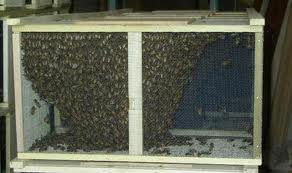
I picked up my package of honey bees the other day. This is one of two methods that a new hive is started if you are beginning from scratch. This method has three pounds of bees with a queen been in her own little queen box. The idea is that the new beekeeper has the hive ready and waiting, removes the queen box, a matchbox sized container that keeps the queen separate from her swarm, and installs the little box in the waiting hive.
Because the queen is trapped in her little cage, it takes a day or two for the swarm to set her free. This trick is performed by eating through the sugar candy that plugs the escape hole.
So, once the queen box is placed in the hive, the whole rest of the package is also set in the hive and let to sit. The bees will leave that box and swarm to protect the queen and, indeed, as I mentioned, work to set her free.
This is where I’m at now and am just waiting for the bees to work and set her free.
So, while I wait I read:
The winter of 2012-13 was another rough one for honeybees, threatening an industry that is integral to a large part of fruit and vegetable production in the U.S. said the number of honeybee colonies declined 31% last winter, by about 800,000 colonies, the latest reported toll of the mass die-offs with multiple causes that have been plaguing the U.S. for several years.
The impact of the premature deaths is significant for the honeybee industry and the broader agriculture industry. Beekeepers can generally bring populations back up during the warmer months, but while they do so, honey production can suffer. Also, the largest single driver of demand for bee colonies is California’s almond crop, which requires bees for pollination and blooms toward the end of the winter when bee populations are at their nadir.
Overall, more than $20 billion of annual harvests rely on pollination, according to U.S. estimates, with the almond harvest alone valued at $4 billion a year.
A 31% failure seems high to me but reports are that it’s been the normal loss since 2006.
But what’s causing these failures?
The Department of Agriculture and the Environmental Protection Agency said last week that “multiple factors” were behind the population declines, including parasites, disease, poor nutrition and pesticide exposure.
Last month, the European Commission said it would soon restrict the use of three seed-coating pesticides known as neonicotinoids while scientists review concerns about the chemicals’ impact on bee health.
The neonicotinoid pesticides under debate are widely used in the U.S., including on corn in the Midwestern states where many beekeepers keep their hives during the summer. The pesticides are considered less harmful to the environment than other insect killers because they are often applied to the seed and contained within the plant, rather than sprayed onto fields.
U.S. officials said they didn’t have enough evidence to ban neonicotinoids and warned that other pesticides could be more harmful to the environment.
From what I’ve been able to read and understand, the beekeeper goes to the bee yard to check on the hives and finds that some of those hives have simply “failed”. It’s a here today gone tomorrow kinda scenario. In fact, there isn’t any evidence of dead bees; they’ve simply abandoned their hive and left the queen to die.
While I tend to believe that the chemicals we use on our crops has an impact on the bees, my intuition tells me that we would see dead bees. Further, hives wouldn’t simply thrive and then fail, they would struggle, shrink and perhaps stop producing. With a average lifespan of only 6 weeks, the bees would be impacted by “poison” somewhere along the way, but it would seem to hit bees at a certain point in the lifecycle.
That is, exposure to these pesticides would begin to kill of bees at week, say 3.5. But the younger bees wouldn’t yet be affected.
And the pattern doesn’t hold.
So, what else could it be?
When I went to move the queen box from that package into my hive, I noticed that the queen wasn’t alone; there were about 3-4 other bees in that little cage. I became worried that she had been “infiltrated”, killed, escaped or whatever. So I called a guy and asked him. He assured me that such arrangements are normal and I had nothing to worry about. I asked him about CCD and it’s causes.
He mentioned mites.
This sounds to me like a strong possibility.
The mites attack the bee brood, killing the young yet to be hatched bee and laying eggs in the cell. The first is always a female with the remaining 3-4 being males. They then move on to the next cell and so on.
The bees are not able to kill the mites and really try just to build comb around them and keep them separated from the rest of the hive. My guess….when the hive becomes too infested with the mites, the hive swarms and leaves the nest to find a new home. No dead bees, no hive failure, just a natural method of out with the old and in with the new.
As I build experience with my new pets, I’ll investigate and try to develop a strategy for those pesky mites. A strategy that doesn’t destroy my crop of honey along the way!







